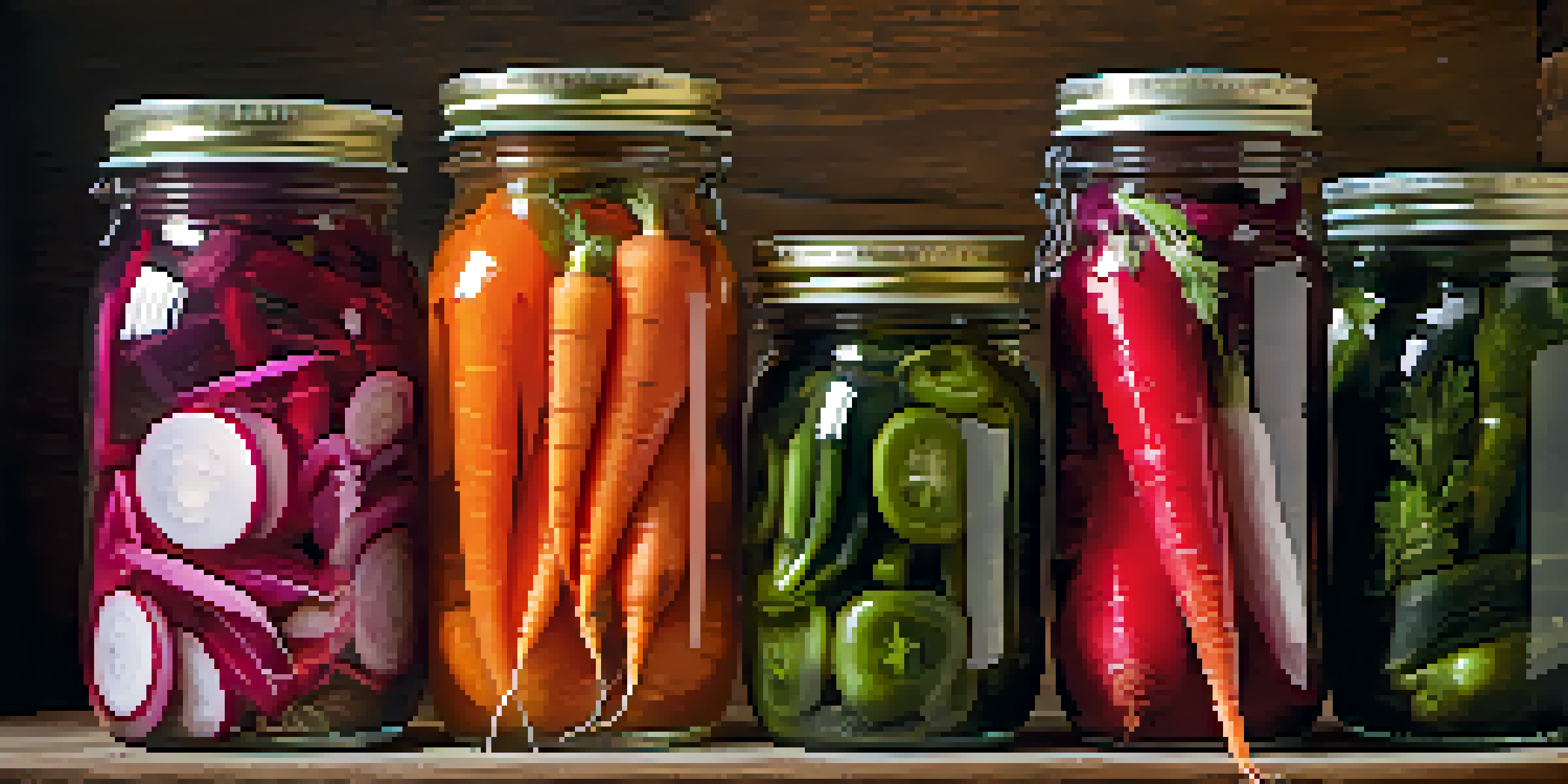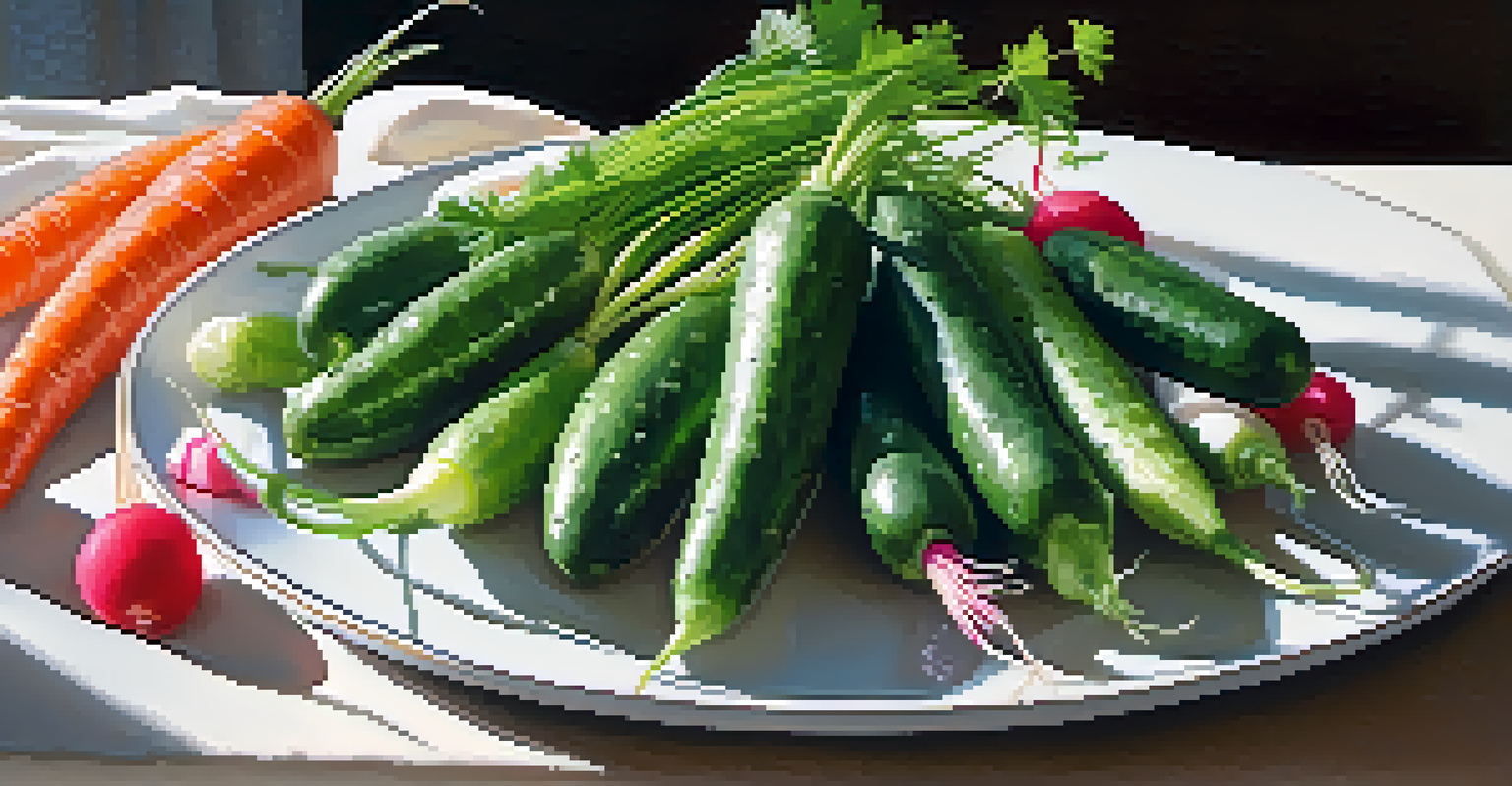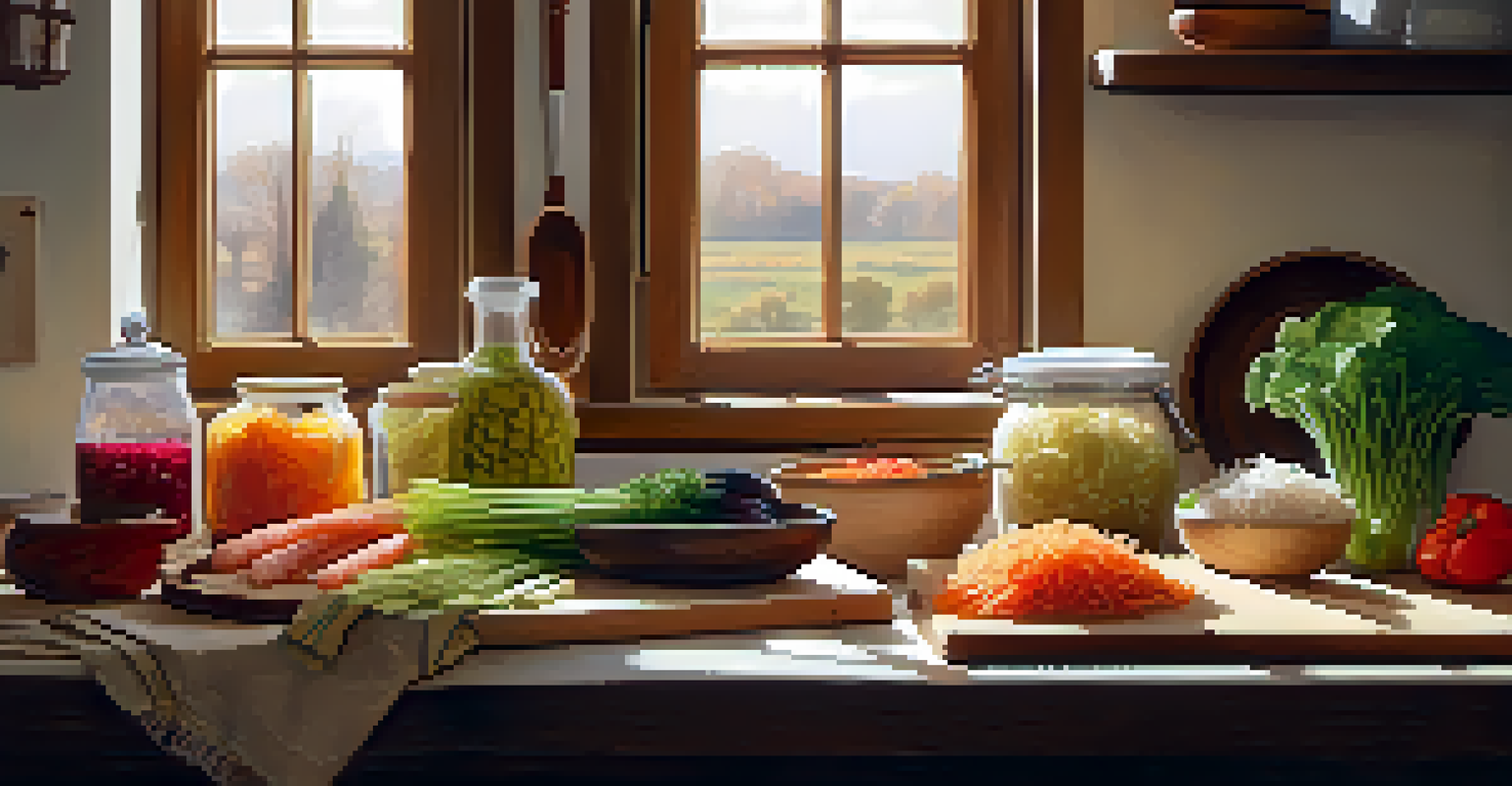Curing Techniques: Preserving and Flavoring Vegetables

Understanding Curing Techniques for Vegetables
Curing is an age-old method of food preservation that extends the shelf life of vegetables while enhancing their flavors. It involves processes like salting, smoking, and fermenting, which not only inhibit spoilage but also add distinctive tastes. Think of it as a way to 'marinate' vegetables in time, allowing them to develop complex flavors that fresh produce simply can’t match.
Food is not just what we eat, but how we eat it.
For instance, pickling cucumbers in a vinegar solution transforms them into zesty pickles, making them a delightful addition to sandwiches or salads. Similarly, fermenting cabbage into sauerkraut not only preserves it but also introduces beneficial probiotics. These techniques provide not just preservation but also a culinary adventure that can elevate everyday meals.
Moreover, understanding these techniques allows home cooks to experiment with flavors and textures. Whether you’re a seasoned chef or a kitchen novice, incorporating curing methods can bring a whole new dimension to your vegetable dishes, making them exciting and versatile.
The Art of Salting: A Time-Tested Technique
Salting is one of the simplest yet most effective curing techniques. By drawing moisture out of vegetables, salt prevents spoilage and creates a concentrated flavor profile. Imagine biting into a salty, crisp cucumber that has been brined just right; it’s a refreshing treat that highlights the vegetable's natural crunch.

Vegetables like radishes and carrots can be salted and left to sit for a few hours, resulting in a deliciously tangy snack. This technique not only preserves but also enhances the natural sweetness and texture of the vegetables, making them perfect for salads or as standalone appetizers. The key is to find the right balance of salt to ensure the vegetables remain enjoyable rather than overly salty.
Curing Enhances Vegetable Flavor
Curing techniques like salting, pickling, and fermenting not only preserve vegetables but also elevate their taste and texture.
Additionally, salting opens the door to a variety of dishes. Once cured, these vegetables can be tossed in salads, used as toppings, or even incorporated into dips, adding layers of flavor and nutrition to your meals.
Exploring Pickling: A Flavorful Preservation Method
Pickling is a popular method that involves immersing vegetables in a vinegar-based solution, often with added spices and herbs. This technique not only preserves the vegetables but also infuses them with vibrant flavors. Picture a jar of pickled jalapeños—spicy, tangy, and a perfect topping for tacos or nachos.
The best way to preserve food is to share it with others.
The beauty of pickling lies in its versatility; almost any vegetable can be pickled, from carrots and radishes to green beans and beets. Each vegetable brings its unique flavor, and the pickling solution can be customized with a variety of spices, allowing for endless flavor combinations. This is a fantastic way to experiment with taste while preserving seasonal produce.
Moreover, pickled vegetables can be stored for months, making them a convenient option for adding zest to your meals. Whether you enjoy them straight from the jar or as part of a larger dish, pickled veggies are sure to brighten up your plate.
Fermentation: A Healthy Approach to Curing
Fermentation is a fascinating process that not only preserves vegetables but also enhances their health benefits. By allowing beneficial bacteria to thrive, fermented vegetables like kimchi or sauerkraut become rich in probiotics, which are great for gut health. It’s like giving your vegetables a little health boost while enjoying their delicious tangy flavor.
The fermentation process often involves just salt and time, allowing naturally occurring bacteria to do their work. For example, when cabbage is fermented, its flavor evolves from crisp and mild to sour and complex, making it a fantastic addition to any meal. Plus, you can experiment with a range of spices and vegetables to create unique variations.
Versatile Methods for Home Cooks
Home cooks can experiment with various curing methods to create unique and exciting dishes that showcase seasonal produce.
Incorporating fermented vegetables into your diet can be a simple way to enhance your meals. Whether you’re stirring sauerkraut into a hearty stew or topping a sandwich with tangy kimchi, these flavorful additions can transform ordinary dishes into extraordinary culinary experiences.
Smoking: Adding Depth to Vegetable Flavors
Smoking is a curing technique that brings an entirely new layer of flavor to vegetables. By exposing them to smoke from burning wood, you can create rich, smoky flavors that are both unique and delicious. Imagine the taste of smoked eggplant, which adds a depth to dips like baba ghanoush that fresh eggplant simply cannot achieve.
This technique works well with a variety of vegetables, including peppers, tomatoes, and mushrooms. The key is to control the smoking process to avoid overpowering the natural flavors of the vegetables. A gentle smoke can enhance their taste without masking their inherent qualities, making them a delightful addition to any dish.
Moreover, smoked vegetables can be used in a variety of recipes, from salads to pastas, providing a gourmet touch. If you’re looking to impress guests at your next gathering, serving smoked vegetable platters can be a conversation starter and a culinary highlight.
Combining Techniques for Unique Flavor Profiles
One of the exciting aspects of curing techniques is the opportunity to combine methods for even more intriguing flavors. For example, you might choose to pickle and then smoke carrots, creating a sweet and smoky treat that stands out on any plate. This fusion of techniques allows for creative expression in the kitchen.
Experimenting with combinations can lead to delightful surprises. Consider fermenting jalapeños and then using them in a pickling brine for an extra kick, or salting cucumbers before pickling for a crunchier texture. The possibilities are endless, and this kind of experimentation can turn everyday vegetables into gourmet delights.
Creative Combinations for Unique Dishes
Combining different curing techniques allows for innovative flavor profiles, transforming ordinary vegetables into gourmet delights.
Additionally, blending techniques not only preserves but also showcases the versatility of vegetables. By finding a balance of flavors and textures, you can create dishes that are both visually appealing and delicious, making your meals memorable.
Storing and Using Cured Vegetables Effectively
Once you’ve cured your vegetables, proper storage is crucial to maintaining their quality. Most cured vegetables can be stored in airtight containers in the fridge or, for longer storage, in a cool, dark pantry. This ensures they remain fresh and flavorful until you’re ready to use them.
When it comes to using cured vegetables, think beyond typical applications. They can be added to soups, stews, or grain bowls, or even used as toppings for pizzas and burgers. Their concentrated flavors can elevate dishes and add a burst of color, making your meals not only tasty but visually appealing.

Moreover, incorporating cured vegetables into your cooking can inspire creativity. You might find that a simple dish becomes a culinary masterpiece with the inclusion of a few well-placed cured ingredients. So, don’t hesitate to experiment and let these flavors shine in your kitchen.